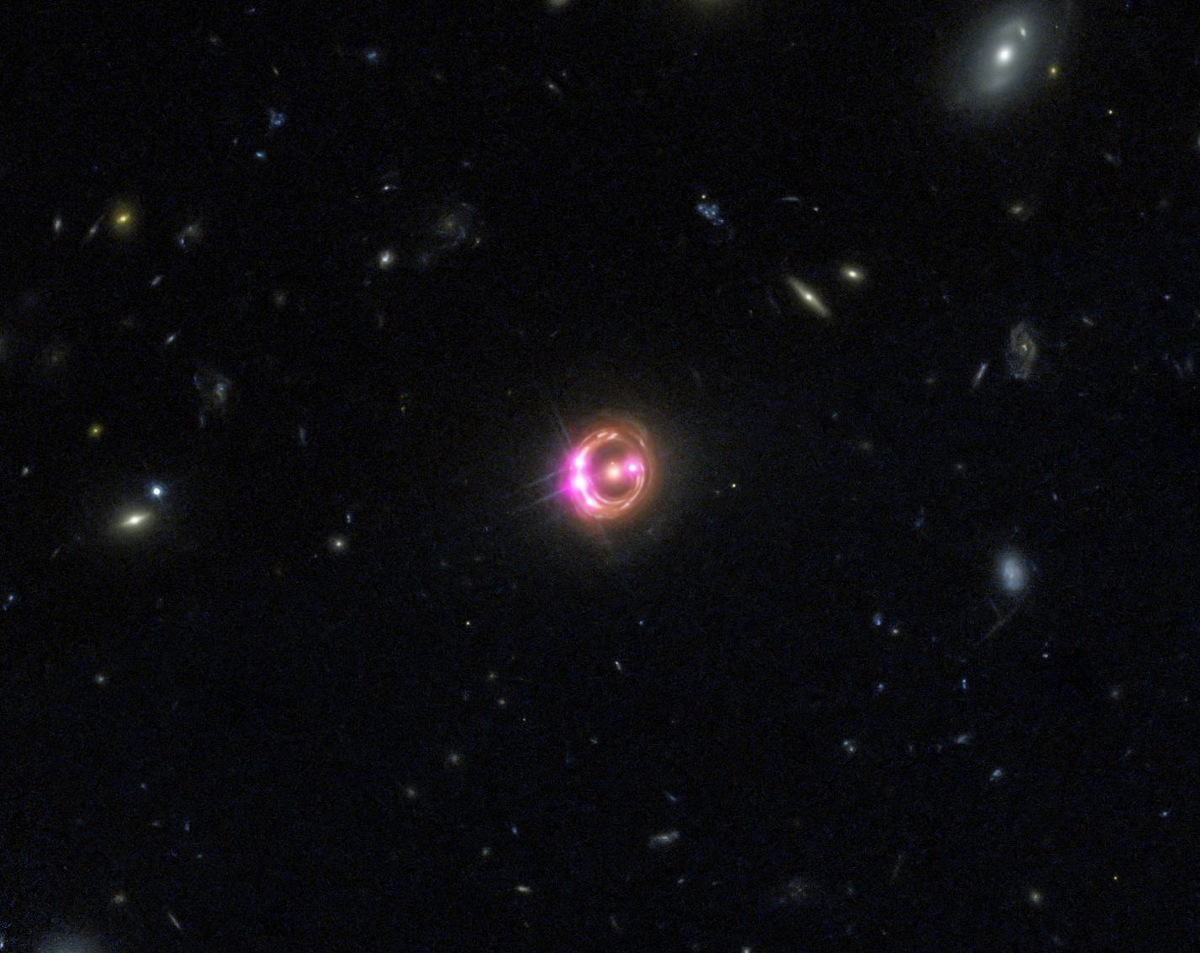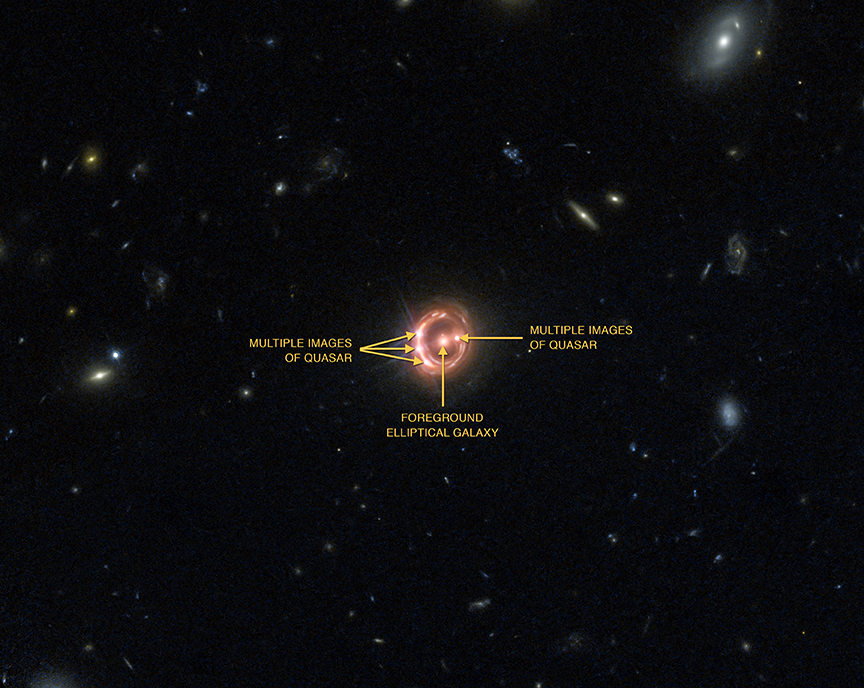Monster Black Hole Spins at Half the Speed of Light

For the first time, astronomers have directly measured how fast a black hole spins, clocking its rotation at nearly half the speed of light.
The distant supermassive black hole would ordinarily be too faint to measure, but a rare lineup with a massive elliptical galaxy created a natural telescope known as a gravitational lens that allowed scientists to study the faraway object.
"The gravitational lens is crucial," study co-author Mark Reynolds of the University of Michigan told Space.com via email.."Without this, we would not be able to collect X-ray photons to measure the spin of a black hole that is so distant." [The Strangest Black Holes in the Universe]
![Black holes are strange regions where gravity is strong enough to bend light, warp space and distort time. [See how black holes work in this SPACE.com infographic.]](https://cdn.mos.cms.futurecdn.net/8GbuLi8DVtx8HoZeSyndT7.jpg)
Nature's free telescope
Just more than 6 billion light-years from Earth, a supermassive black hole powers the quasar . Quasars, the most luminous objects in the universe, shine brightly across vast distances, fed by material that falls into their black holes.
Black holes are massive objects whose gravitational pull is so powerful that even light cannot escape their grasp. Most form when a star at the end of its lifetime explodes, its outer core collapsing into a tiny dense ball.
Supermassive black holes have masses millions of times that of the sun and are found at the center of most galaxies, including the Milky Way. Their origins are still unknown.
Get the Space.com Newsletter
Breaking space news, the latest updates on rocket launches, skywatching events and more!
The only features scientists are able to measure about the voracious objects are their mass and spin. Astronomers can determine the mass of a black hole by measuring its interactions with gas and other objects, but characterizing its rotation has remained a challenge, especially for more distant supermassive black holes.
In the new study, a team led by Rubens Reis of the University of Michigan used NASA's Chandra X-ray Observatory and the European Space Agency's XMM-Newton — the largest X-ray space telescopes currently available — to observe the X-rays generated in the innermost regions of the disk of material circling and feeding the supermassive black hole that powers the quasar J1131.
Measuring the radius of the disk allowed the astronomers to calculate the black hole's spin speed, which was almost half the speed of light.
The team would have been unable to measure the spin without a rare lineup in space. A giant elliptical galaxy lies between Earth and the quasar J1131. The huge galaxy acts as a gravitational lens to bend and magnify objects that lie behind it — in this case, the supermassive black hole.
"It acts like a telescope, but a free one provided by nature," Reynolds said.
"Such a quadruple lens of a quasar is a very rare object," Guido Risaliti, of the Harvard-Smithsonian Center for Astrophysics, told Space.com in an email. "Until a few years ago, none of them was known."
Risaliti, who was not involved in the research, also studies supermassive black holes. Last year, he made the first reliable measurement of the spin of a nearby supermassive black hole. He authored a News & Views article that appeared along with the research in the journal Nature today (March 5). [No Escape: Dive Into a Black Hole (Infographic)]

Super spinner
The spin of a supermassive black hole can reveal information about how it accretes the material it consumes. To achieve a rapid spin, material must fall into the black hole in a direction similar to its rotation, ultimately revving it up like a child spinning a merry-go-round.
A slower spin indicates that the gas and dust supplying the black hole fall into it from multiple directions, spinning the black hole up or down depending on whether it comes in with or against the rotation. In this case, the random influx of material acts like a child alternating pushing and pulling the merry-go-round.
The quick spin of J1131 indicates that the black hole is being fed by a bountiful supply of gas and dust. These large volumes could be provided by collisions and mergers between galaxies, among other sources, Reynolds said.
A slower spin and more haphazard feeding process would be caused by material arriving in spurts, from interstellar gas clouds and stars wandering too close from a variety of directions.
"Observational studies over the past 20 years have shown a clear link between the mass of the supermassive black hole at the center of a galaxy and the properties of the galaxy in which it resides," Reynolds said. "These relations suggest a symbiotic relationship between the central black hole and its host galaxy."
By studying the black hole, astronomers can learn more about the origin and evolution of galaxies — and spin plays a very important role.
"The growth history of a supermassive black hole is encoded in its spin," Reynolds said.

"The next immediate step is to obtain a few more black hole spins in the nearby AGN, but it will be difficult to repeat observations like the one of Reis' team due to the rarity of these sources," Risaliti said. "The big step forward will be the measurements of the black hole spins with the next generation of high sensitivity X-ray telescopes, such as the ESA's Athena."
Follow us @Spacedotcom, Facebook or Google+. Originally published on Space.com.
Join our Space Forums to keep talking space on the latest missions, night sky and more! And if you have a news tip, correction or comment, let us know at: community@space.com.

Nola Taylor Tillman is a contributing writer for Space.com. She loves all things space and astronomy-related, and enjoys the opportunity to learn more. She has a Bachelor’s degree in English and Astrophysics from Agnes Scott college and served as an intern at Sky & Telescope magazine. In her free time, she homeschools her four children. Follow her on Twitter at @NolaTRedd









